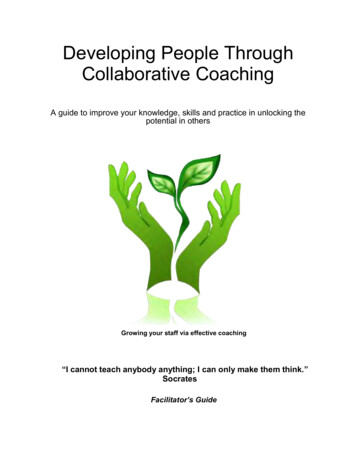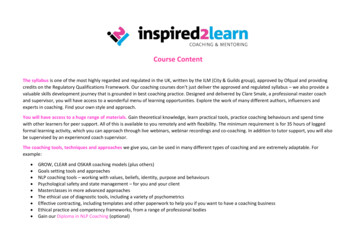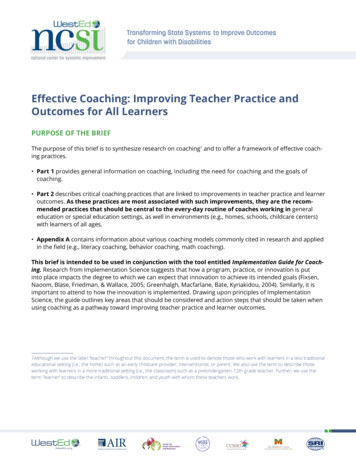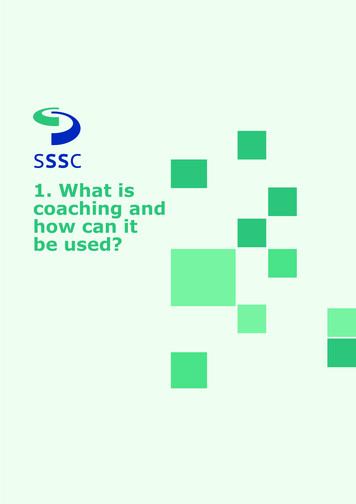
Transcription
Building aCoaching Culture forChange Management
TABLE OF CONTENTSExecutive SummaryDefinitions of Key Terms35Introduction6Organizational Change7Roles in Change ManagementCoaching for Change ManagementIn Their Own Words—Coaching and Change ManagementBuilding a Coaching Culture11121618Determining the Value of a Strong Coaching Culture19Coaching Modalities Shared22Coach-specific Training23Access to Coaching25Investment in Coaching25Conclusions and Recommendations26AppendicesEnd Notes28About the Research29Survey Respondent Demographics31About the Research Partners33BUILDING A COACHING CULTURE FOR CHANGE MANAGEMENT 2
EXECUTIVE SUMMARYAlthough individuals personally experience change, HR and changemanagement practitioners design, execute and often unsuccessfullysustain change at the organizational level. From large-scale changemanagement initiatives (e.g., mergers and acquisitions, globalexpansion, downsizing) to changes at the team level (e.g., adoptingnew technology, team leadership transition), people understand andreact to change differently because of their assumptions, expectationsand perspectives. When people experience change as somethingthat is happening to them rather than something they are integralto, they become resistant to the change. Coaching is a powerful toolto develop the potential of employees, modify behaviors and drivebusiness success. Because of this, it can help individuals, teams andorganizations explore resistance, enhance communication and promoteresilience in the face of change.For the fifth consecutive year, the Human Capital Institute (HCI)and the International Coach Federation (ICF) partnered to researchcoaching cultures in organizations. This year’s research focuses onchange management and the role of coaching in change managementinitiatives. There was a total of 432 participants in this study, whichincluded Human Resources (HR), Learning and Development (L&D), andTalent Management (TM) professionals; internal coach practitioners;managers; and individual contributors. Key research findings include:High-performing organizations1 have stronger change managementcapabilities.High-performing organizations are more likely to report thatchange management initiatives meet or exceed their expectationsfor success.A quarter or less of respondents are confident in their employees’change capabilities, but there is greater confidence overall athigh-performing organizations.BUILDING A COACHING CULTURE FOR CHANGE MANAGEMENT 3
“Common changemanagement approachesoften center around tactics,logistics and metrics.The difference with ouremphasis is the first and lastcomponents of any changeneed to be centeredCoaching is one of the most helpful ways to develop changemanagement capabilities.The most frequently cited activities for change management areclassroom training, e-learning and face time with senior leaders.However, coaching activities (e.g., one-on-one coaching, teamcoaching and work group coaching with a professional coachpractitioner) are rated as the most helpful in achieving the goals ofchange management initiatives.and focused onpeople.”Addressing leadership style, strengths and blind spots;— RACHEL ENOCHS, PHR,MANAGER, ORGANIZATIONALDEVELOPMENT AND LEARNING,UNIVERSITY HOSPITALSreasons for using coaching activities for change management.overcoming resistance; building resilience and change readiness;and finding processes and tools are the most frequently citedUsing coaching to lead an agile culture is correlated with greaterconfidence in employees’ capabilities in planning and executingchange.Organizations with strong coaching cultures are more likely to havebetter talent and business outcomes.Fifteen percent of respondents have a strong coaching culture attheir organizations.Among organizations with a strong coaching culture,approximately three in five (61%) are also classified as highperforming organizationsA strong coaching culture is correlated with most of the indicatorsof a high-performing organization including success at large-scalestrategic change.BUILDING A COACHING CULTURE FOR CHANGE MANAGEMENT 4
Definitions of Key TermsChange management initiative: any project or task that applies astructured approach to transition an organization from a current state toa future state to achieve expected benefits.Coaching: partnering with coachee(s) in a thought-provoking andcreative process that inspires them to maximize their personal andprofessional potential.Manager/leader using coaching skills: a leader who uses coachingknowledge, approaches and skills to create awareness and supportbehavior change.Professional coach practitioner: someone who provides an ongoingpartnership designed to help coachees produce fulfilling results in theirpersonal and professional lives. The coach’s job is to provide support toenhance the skills, resources and creativity that the coachee already has.Internal coach: a professional coach practitioner, who is employedwithin an organization and has specific coaching responsibilitiesidentified in their job description.External coach: a professional coach practitioner, who is either selfemployed or partners with other professional coaches, to form acoaching business.Coach-specific training: training that teaches coaching competenciesand/or how to apply technical skills in a coach-like manner, and thatencompasses theories and core coaching competencies designed toprepare an individual to practice as a professional coach.Accredited coach training program: any program consisting of coachspecific training that has met the rigid criteria required to be approvedby a professional coaching organization.Team: small number of people with complementary skills, who arecommitted to a common purpose, performance goals and approach, forwhich they hold themselves mutually accountable.Work group: intact group whose members’ activities are interdependent;they are responsible for collectively performing tasks and producingoutcomes in the context of a larger organizational system.BUILDING A COACHING CULTURE FOR CHANGE MANAGEMENT 5
INTRODUCTIONSeventy-seven percent of HR practitioners and leaders report thattheir organization is in a state of constant change with continuouslyshifting priorities and strategies. Additionally, 85% of organizations haveexperienced an unsuccessful change management initiative in the pasttwo years.2 Although change can be continuous or episodic,3 manyorganizations struggle to navigate and sustain their change managementinitiatives while simultaneously placing importance on changemanagement capabilities. In recent research on coaching and Millennialleaders, managing and successfully introducing change was rankedfourth among 10 valuable competencies for first-time people managers.4Frequent challenges to change management include personalresistance to change, poor communication, insufficient trainingand a failure to prioritize new initiatives.5 Researchers and changemanagement practitioners have identified many factors that contributeto the success of change initiatives, including active and visibleexecutive sponsorship; a structured change management approach;dedicated change management resources and funding; frequent andopen communication about the change and the need for change;and engagement, support, and participation from employees, middlemanagers, and project managers.6How do leaders, managers, and HR, L&D and Talent Managementpractitioners empower their people to execute their organization’svision and thrive in a world of constant change? This research reportexplores how coaching can be integrated with change managementinitiatives to build change capabilities, increase change readiness andaddress resistance. Using a combination of surveys and interviews withsubject-matter experts, we explore the best practices for building astrong coaching culture for change management.BUILDING A COACHING CULTURE FOR CHANGE MANAGEMENT 6
“Change is natural. It’s thefear of the unknown thatcauses us to push back. Ifwe use coaching to create asafe, supportive relationshipwhere we can help peopleexplore different possibilitiesand consider how makingsome of these changes helpthem achieve what’s mostimportant to them, wecan get them moreinvested in thatchange. And there’s agreater chance they’re goingto follow through and do thethings they need to do tomake the change.”ORGANIZATIONAL CHANGEMany change management initiatives occur in parallel, adding to thecomplexity of an already challenging process. Business and HR processimplementations, technology changes, leadership changes, newproduct development and environmental/regulatory/legal changes arethe most common change management initiatives (Figure 1).We asked survey respondents to rate how well each of their changemanagement initiatives met expectations for success. We found thatrespondents from organizations with fewer employees are morelikely to report success for organization-wide technology change,7 aspecific department or team technology change,8 and business processimplementation.9 Respondents from organizations with more employeesare more likely to report success at industry and digital disruption.10High-performing organizations that report the strongest talent andbusiness outcomes among their peers11 are more likely to report thatchange management initiatives meet or exceed their expectations forsuccess (Figure 1).—J. MATTHEW BECKER M.ED.,MCC, COACHING AND MENTORINGMANAGER, CARESOURCEBUILDING A COACHING CULTURE FOR CHANGE MANAGEMENT 7
FIGURE 1Occurred withinthe past two yearsBusiness processimplementation(89%)Specific departmentor team technologychange(83%)HR ogy change(82%)Change of leadership(80%)New gulatory/legalchanges(74%)Workforce n(54%)Global/regionalexpansion(51%)Mergers andacquisitions(47%)Of the change management initiatives at your organization overthe past two years, what has occurred? —AND—Of the changemanagement initiatives at your organization over the past two years,how would you rate its current success? (Percentage reporting:Equals, Exceeds and Far Exceeds %94%93%All otherorganizationsBUILDING A COACHING CULTURE FOR CHANGE MANAGEMENT 8
High-performing organizations may be more successful meeting orexceeding the goals and objectives for the change because theirworkforce has stronger change management capabilities. Respondentsat high-performing organizations report greater confidence in theiremployees’ abilities to plan for, execute and sustain change (Figure 2).FIGURE 2Employees can plan for changeHow confident are you that employees within your organization canplan for, execute and sustain change? (Percentage reporting: VeryConfident and Extremely Confident)13%Employees can execute changeEmployees can sustain ��We can build things reallyquickly. But then whenit comes to the adoptionpiece, that is where thewheels tend to fall off. Thereal success willbe when there’sadoption and whenyou start to see the needlebeing moved in terms of lessresistance to some of the newideas and more embracing ofthose ideas or approaches.”— KELLI CLARK, CORPORATECOMMUNICATIONS AND CHANGEMANAGEMENT, EXELONAll otherorganizationsWe asked respondents to think about the most and least successfulexamples of change management in their organization and choosewords that characterized the initiatives. The most frequently cited wordsassociated with successful change management were communication,involvement, planning and leadership.12 The most frequently citedwords associated with unsuccessful change management werecommunication, leadership and planning.13 This overlap matters.Communication, leadership and planning represent three core featuresof change management initiatives which determine either their successor their failure.Further descriptors of successful change management initiativesincluded focus, consistency, innovation, organized and stakeholder(Figure 3). Further descriptors of unsuccessful change managementinitiatives included resistance, unclear, fear, rushed and confusion(Figure 4). The takeaway? To be successful, individuals with formal rolesin change management need to focus the effort, provide consistencyand organization for the stakeholders, and address resistance, fear andunclear expectations and information gaps.BUILDING A COACHING CULTURE FOR CHANGE MANAGEMENT 9
FIGURE 3Thinking about the MOST successful change management initiativesin the past two years, what three words or phrases would you chooseto describe why they were successful?FIGURE 4Thinking about the LEAST successful change management initiativesin the past two years, what three words or phrases would you chooseto describe why they failed?BUILDING A COACHING CULTURE FOR CHANGE MANAGEMENT 10
Roles in Change ManagementAmong the 11 types of change management initiatives listed in thesurvey, the typical respondent reported a mean of seven changemanagement initiatives occurring at their organizations over the pasttwo years. HR/Talent Management/L&D professionals who use coachingskills and managers/leaders who use coaching skills are most likely tobe involved in change management initiatives. Of the formal roles inchange management, those who implement the change, communicatethe change and gather feedback on the change have the mostinvolvement across the stages (Figure 5).Although it was one of the change management roles cited the least,the next section of this report shows that the use of professionalcoaching practitioners is considered among the most helpful activitiesin achieving the goals of a change management initiative.FIGURE 5In the past two years, what role(s) have you had during changemanagement initiatives and at which stages during the change didyou play your role?Change Management StageChange Management RolePlanningExecutingSustainingDerailingPlan and design change65%52%40%30%Communicate the change59%65%47%31%Implement the change on my team59%68%56%34%Gather feedback on change53%62%54%38%Change management leader51%52%41%31%Project or program manager49%47%35%26%Evaluate the impact of the t sponsor41%38%28%20%Professional coach practitioner29%35%25%18%BUILDING A COACHING CULTURE FOR CHANGE MANAGEMENT 11
COACHING FOR CHANGE MANAGEMENTHigh-performing organizations are more likely to include learning anddevelopment activities as part of their change management initiatives(Figure 6). These activities are for the entire workforce—not only leaders—and enable individuals to learn about the change, build skills and adaptbehaviors. The most frequently cited L&D activities for change managementare classroom training, e-learning and facetime with senior leaders.FIGURE 6Percentage offering activityClassroom training(59%)Web-based trainingor e-learning(57%)Meetings/facetime withsenior leaders(49%)Access to manager/leader using coachingskills(38%)Stretch assignmentsor job rotations(35%)Assessments(35%)One-on-one coachingwith professional coachpractitioner(29%)Peer networking atevents or conferences(26%)Team coaching withprofessional coachpractitioner(25%)Formal mentoringprograms(23%)Work group coachingwith professional coachpractioner(16%)Over the past two years, which of these activities has your organizationoffered as part of a change management initiative? (Select all that sAll otherorganizationsBUILDING A COACHING CULTURE FOR CHANGE MANAGEMENT 12
Coaching-related activities are rated as the most helpful in achievingthe goals of change management initiative(s) (Figures 7 and 8). Unlikebroader development activities like training or e-learning, coaching istailored to the needs of the individual employee, team or work group,since the process is driven by the coachee(s) rather than the coach.FIGURE 7Of what was present in your organization, how helpful was the activityin achieving the goals of the change management initiative(s)?(Percentage reporting Moderately Helpful are not displayed here.)Work group coaching withprofessional coach practitioner2%78%One-on-one coaching withprofessional coach practitioner3%78%Meetings/facetimewith senior leadersAction learningLearning labs7%2%73%9%Access to manager/leaderusing coaching skills4%Stretch assignmentsor job rotations4%Team coaching with professionalcoach practitioner2%Formal mentoring programs74%70%67%67%7%65%Peer networking at eventsor conferences11%Assessments11%Classroom trainingMicro-learning contentWeb-based training or e-learning72%58%55%13%16%23%49%44%34%Not at All Helpful/Slightly HelpfulVery Helpful/Extremely HelpfulWhen grouping these activities into four thematic categories, coachingis rated the most helpful in achieving the goals of the changemanagement initiative (Figure 8).BUILDING A COACHING CULTURE FOR CHANGE MANAGEMENT 13
FIGURE 8CoachingOf what was present in your organization, how helpful wasthe activity in achieving the goals of the change managementinitiative(s)? (Percentage reporting: Very and Extremely Helpful.)Formal LearningPeer LearningOn-the-Job LearningOne-on-onecoaching withprofessional coachpractitioner78% Classroom training 49% with senior leaders 74% assignmentsWork groupcoaching withprofessional coachpractitioner78% AssessmentsAccess tomanager/leaderusing coachingskills70% contentTeam coachingwith professionalcoach practitioner67% training orMeetings/facetimeFormal mentoring55% programsPeer networkingMicro-learning65% Learning labs73%72%Stretch44% at events or58% assignments or job 67%conferencesWeb-basedAction learningrotations34%e-learningSurvey respondents appear to be both proactive and expansive withthe use of coaching throughout the change management stages, ratherthan relying on coaching only as an attempt to save a derailing project(Figure 9).FIGURE 9In the past two years, when was coaching offered as part of a changemanagement initiative? (Select all that apply.)Change Management ilingTeam coaching with professionalcoach practitioner15%39%45%30%14%Work group coaching withprofessional coach practitioner10%43%43%29%11%One-on-one coaching withprofessional coach practitioner29%29%37%33%22%Access to manager/leader usingcoaching skills30%58%46%46%23%Coaching ActivitiesBUILDING A COACHING CULTURE FOR CHANGE MANAGEMENT 14
The most frequently cited applications for using coaching for changemanagement activities include addressing leadership style, strengthsand blind spots; overcoming resistance; building resilience; buildingchange readiness; and finding processes and tools (Figure 10). Usingcoaching to develop managers/leaders to lead an agile culture iscorrelated with respondents’ greater confidence in employees’ abilitiesto plan and execute change.14FIGURE 10In the past two years, how has coaching been used with your changemanagement initiatives? (Select all that apply.)Personal leadership style,strengths and blind spotsOvercoming resistanceProcesses and toolsPersonal ering partnerships andbuilding change teamsLeading an agile cultureModels and methodsStress managementDeveloping change agentsCoaching ApplicationsTeam coaching with professionalcoach practitioner81%70%67%66%59%56%53%46%42%42%Work group coaching withprofessional coach ne coaching withprofessional coach practitioner76%64%52%62%60%52%48%37%44%35%Access to manager/leader usingcoaching skills72%62%58%54%59%51%47%39%37%41%Coaching Activities“Everybody is unique, and everybody needs anopportunity to talk through what are theyfeeling about this. How is this change impacting them?What are their concerns? What are they excited about? Ifwe miss that individual opportunity, I don’t think it will be assuccessful.”—J. MATTHEW BECKER M.ED., MCC, COACHING AND MENTORINGMANAGER, CARESOURCEBUILDING A COACHING CULTURE FOR CHANGE MANAGEMENT 15
IN THEIR OWN WORDS:Coaching and ChangeManagementOrganizations rely on coaching as part of their change managementinitiatives for many reasons. A selection of open-text responses from 156respondents is below.EMOTIONAL, SOCIAL ANDPROCESS SUPPORT (33%)“It’s important to have somebody you trust who can help guide youand answer questions to ensure you are comfortable to accept andembrace change”“During a major acquisition, many changes occurred which causedsome anxiety and required HR and leaders to ensure communicationsand transparency were constant and that employees received properchange management coaching.”USE AN EVIDENCE- ANDEXPERIENCE-BASEDPRACTICE (24%)“Coaching is a successful developmental process that is proven toMANAGERIALAPPROACHES ANDABILITIES DEVELOPMENT(22%)“We have a small leadership team, and many come from within theaccelerate the growth of key talent to meet organizational needs.”“It has proven to be efficient over time, yielding excellent results.”company so there was a need to have professional development tohelp grow the leadership team. We used a professional coach who [alsoheld a doctoral degree in psychology] and that has helped the teamlearn how to work best with different personalities.”“It’s been a key element in leader development, and ensures consistentprocess toward change goals, as well as providing intervention tomanage stress and change.”ACCELERATE ANDIMPROVE PERFORMANCE(13%)“We use coaching to improve and sustain high performance.”“It works to accelerate the readiness of key talent to take up key positions.”BUILDING A COACHING CULTURE FOR CHANGE MANAGEMENT 16
AS PART OF THE CULTURE(6%)“The culture was not a learning culture and required a paradigm shift.”“We based our coaching efforts on other organizations that havea strong coaching culture. The change initiative was an attempt tomove our culture in that direction. Introducing coaching concepts andencouraging peer coaching was part of that.”TEAM INTEGRATION (3%)“The addition of three top-level executives added to the executive teamthat was made up of the CEO and COO. Coaching was used/[is] stillbeing used to help the executive team become a strong unit and in turnuse these coaching skills with their direct reports and the direct reportsto their reports.”BUILDING A COACHING CULTURE FOR CHANGE MANAGEMENT 17
BUILDING A COACHING CULTURECoaching was rated as one of the most helpful activities for changemanagement, but how do organizations utilize the power of coaching tobuild change management capabilities and enhance employee readiness?Over the past five years, HCI and ICF have studied how organizationsbuild a strong coaching culture where the development of all employeesis a top priority. Responding organizations who met at least five ofthe criteria in the coaching culture composite were determined tohave strong coaching cultures (Figure 11). Strong coaching culturescomprised 15% of the organizations which participated. This proportionwas similar to what was observed in previous HCI-ICF studies with amean of 17% for the years 2014-2018.FIGURE 11Strong coaching culture composite (Percentage of respondentsindicating the presence of each criterion).CTBUDGE.Coaching. Strongly/somewhat agree thatemployees value coaching78%Strongly/somewhat agree that seniorexecutives value coaching75%Managers/leaders and/or internalcoaches received accredited coachspecific training46%Have all three coaching modalities at theirorganization (internal coach practitioners,external coach practitioners andmanagers/leaders using coaching skills)38%Coaching is a fixture in the organizationwith a dedicated line item in the budget24%All employees in the organizationhave an equal opportunity to receivecoaching from a professional coachpractitioner22% BUILDING A COACHING CULTURE FOR CHANGE MANAGEMENT 18
Determining the Value of a Strong CoachingCultureAmong organizations with a strong coaching culture, 61% are alsoclassified as high-performing organizations. Among organizations withouta strong coaching culture, only 27% are also classified as high-performingorganizations (Figure 12). In other words, strong coaching cultures aremore than twice as likely to be high-performing organizations.FIGURE 12Percentage classified as high-performing organization.Strong coaching cultureNot a strong coaching ching is acriticalskill for all to developin a constantly changingworld. It helps move peopleon and helps them createoptions for themselves [in away] that is often hard to doon your own.”39%All otherorganizationsFurthermore, a strong coaching culture is correlated with most of theindicators of a high-performing organization including success at largescale strategic change (Figures 13 and 14).Organizations with a systemic approach to coaching (i.e., strongcoaching cultures) are more likely to observe better talent and businessoutcomes, which can demonstrate the compelling value and impact ofcoaching to employees and senior leaders.—SURVEY RESPONDENTBUILDING A COACHING CULTURE FOR CHANGE MANAGEMENT 19
FIGURE 13How have the following talent and organizational outcomes changedat your organization over the past two years? (Percentage “SlightlyHigher” and “Much Higher” and statistically significant differencesbetween groups at p .05)Investments in employeedevelopment57%Talent OutcomesPercentage of internal hires/promotions (internal mobility)69%39%59%36%Percentage of diverse(minority, gender, age,backgrounds) hiresPercentage of highperformers retained69%48%Employee engagementsurvey scoresPercentage of employeesassessed ready for seniorleadership position (benchstrength)78%42%32%Strong coaching culture58%54%All OthersBUILDING A COACHING CULTURE FOR CHANGE MANAGEMENT 20
FIGURE 14Compared to your industry competitors, how has your organizationfared in the following business dimensions over the past two years?(Percentage “Above Average” and “One of the Best” and statisticallysignificant differences between groups at p .05)Customer satisfaction63%Shareholder valueBusiness Outcomes82%75%54%Employee of choice(talent selection)74%49%Labor productivity65%45%Profitability55%Large-scale strategic change45%Strong coaching culture64%59%All OthersBUILDING A COACHING CULTURE FOR CHANGE MANAGEMENT 21
Coaching Modalities SharedTypically, three different coaching modalities are present withinorganizations: internal professional coach practitioners, externalprofessional coach practitioners, and managers and leaders who usecoaching skills with their team members (Figure 15). While nearly two infive organizations use all three modalities, this figure rises to 92% amongorganizations with strong coaching cultures. Organizations with moreemployees appear more likely to utilize all three coaching modalities.FIGURE 15Three types of coaching modalitiesExternal coachpractitionersManagers/leaders usingcoaching skillsInternal coachpractitionersBUILDING A COACHING CULTURE FOR CHANGE MANAGEMENT 22
Coach-specific TrainingAll professional coach practitioners should adhere to specific competenciesin their practice, training requirements and ethical standards. Managersand leaders who use coaching skills with individuals on their teams shouldunderstand what coaching skills are and practice those skills. Researchersin a recent study found that when managers were asked to “coach”someone else they instead consulted and provided advice. The researchersreferred to the phenomenon as “micromanaging-as-coaching.”15Managers and leaders are most often trained to use coaching skills byL&D departments, HR departments and internal coach practitioners(Figure 16). Thirty-three percent of organizations offer training formanagers and leaders to use coaching skills from a program that wasaccredited/approved by a professional coaching organization (e.g., ICF)and 13% train from an accredited/approved university-based program.FIGURE 16How is coach-specific training currently offered to your managers/leaders using coaching skills?Through our Learning andDevelopment department69%11%20%Through our HR department56%10%34%By internal coach practitioners55%11%34%By external coach practitioners43%From a program that wasaccredited/approved by aprofessional coaching organization33%From a program that was NOTaccredited/approved by aprofessional coaching organizationFrom a university-based programthat was accredited/approved by aprofessional coaching organizationFrom a university-based program thatwas NOT accredited/approved by aprofessional coaching organization8%29%13%7%9% 3%Yes, we offer49%8%59%5%66%79%88%No, we don’t offer butplan to in the futureNo, we don’t offerBUILDING A COACHING CULTURE FOR CHANGE MANAGEMENT 23
Internal coach practitioners are most often trained by other, moreexperienced internal coach practitioners or through L&D andHR departments (Figure 17). Forty-eight percent of respondents’organizations train internal coach practitioners from a program that wasaccredited/approved by a professional coaching organization and 17%train from an accredited/approved university-based program.FIGURE 17How is coach-specific training currently offered to your internal coachpractitioners?67%By internal coach practitionersThrough our Learning andDevelopment department7%60%26%7%32%Through our HR department48%6%46%From a program that wasaccredited/approved by aprofessional coaching organization48%7%45%By external coach practitionersFrom a program that was NOTaccredited/approved by aprofessional coaching organization37%27%From a university-based programthat was accredited/approved by aprofessional coaching organization17%From a university-based program thatwas N
Coach-specific training: training that teaches coaching competencies and/or how to apply technical skills in a coach-like manner, and that encompasses theories and core coaching competencies designed to prepare an individual to practice as a professional coach. Accredited coach training p











